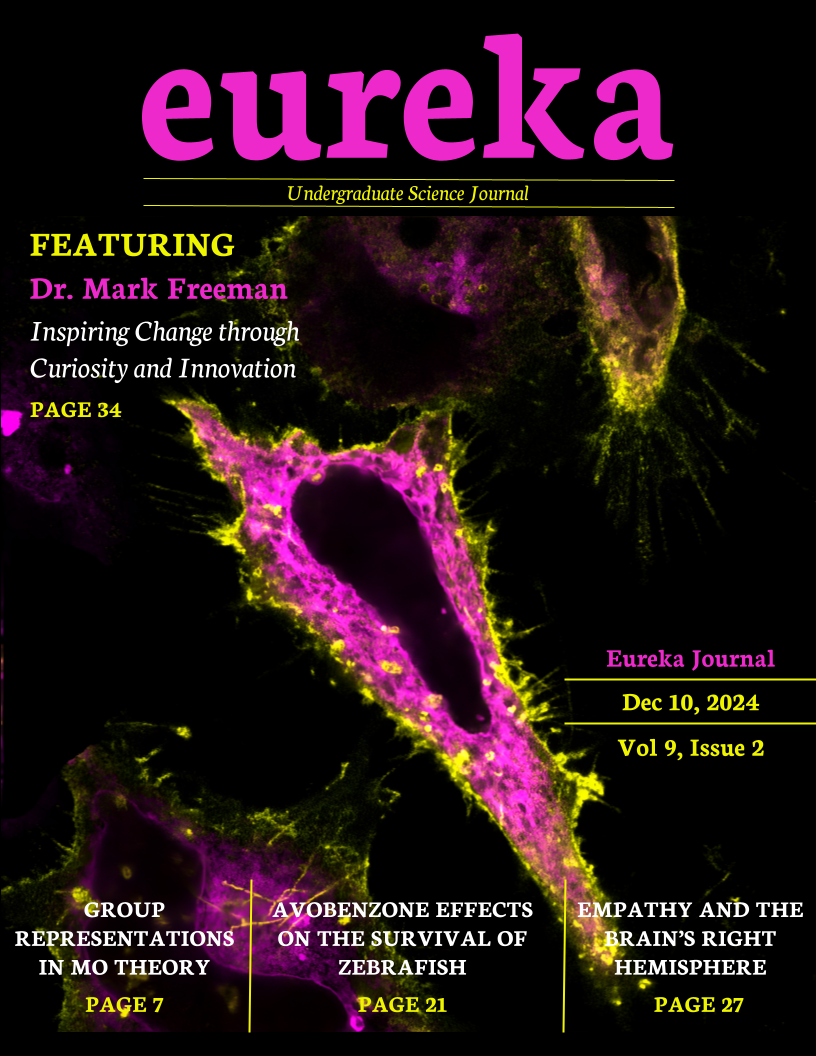Representing The World Around Us: Applications of Group Representation Theory to Molecular Orbital (MO) Theory
DOI:
https://doi.org/10.29173/eureka28818Keywords:
Molecular Orbital (MO) Theory, Group theory, Representation theory, Symmetry-adapted linear combination, Quantum chemistryAbstract
Molecular orbital (MO) theory is a theory at the forefront of modern chemistry, allowing for accurate descriptions of reactivity of molecules by using quantum mechanics to predict the location of electrons within a molecule, and their corresponding energies. The equations which govern their behavior, the Schrodinger equation, are often difficult to solve. Often, we can only approximate a solution using numerical methods. This paper discusses a method which exploits a molecule’s internal symmetry. Specifically, we use Group representation theory to help analyze and break down the molecular symmetry, and then use the analysis to help us find the MO’s. First, we establish key results about irreducible representations and characters. We then establish a correspondence between MO’s and irreducible representations. We then use the results we obtained to perform MO calculations on water (H2O). We then compare the results obtained via our MO theory calculations and Valance Bond Theory (VBT). We conclude by showing these calculations are best used for rough work, being most useful for deciding which atomic orbitals they arose from, and each MO’s energies relative to each other.
Downloads
References
Baez, J. (2020). Noether’s Theorem in a nutshell. https://math.ucr.edu/home/baez/noether.html
Bouchard, V. (2020). MA PH 464 - Group Theory in Physics Lecture notes. In MA PH 464 - Group Theory in Physics. University of Alberta. https://sites.ualberta.ca/~vbouchar/MAPH464/notes.html.
Chua, D. (n.d.). Schur’s lemma. In part II representation theory. https://dec41.user.srcf.net/h/II_L/representation_theory/4
Encyclopedia. (2022). Chemical Bonding of H2O. In Encyclopedia. Encyclopedia. https://encyclopedia.pub/entry/29914#:~:text = In%20addition%2C%20while%20the%20valence,O%20is%20sp2%20hybridized.
Fabian Z. (2024, March 4). Lewis structure. Wikipedia. https://en.wikipedia.org/wiki/Lewis_structure#/media/File:Freie_Elektronenpaare_Wasser_V3.svg
Fulton, W., & Harris, J. (2004). Representation theory: A first course. Springer. https://mat.uab.cat/~pitsch/ReadingSeminar/Fulton-Harris.pdf
Galbraith, J. M., Shaik, S., Danovich, D., Braïda, B., Wu, W., Hiberty, P., Cooper, D. L., Karadakov, P. B., & Dunning, T. H. (2021). Valence bond and molecular orbital: Two powerful theories that nicely complement one another. Journal of Chemical Education, 98(12), 3617–3620. https://doi.org/10.1021/acs.jchemed.1c00919
Kennephol, P. (n.d.). In Personal communication. https://contacts.ucalgary.ca/info/chem/profiles/1-9668525
Lowe, J. P., & Peterson, K. A. (2011). Quantum Chemistry. Academic Press.
Miessler, G. L., Fischer, P. J., & Tarr, D. A. (2022). Inorganic Chemistry. Pearson.
Molecular orbital theory and its symmetry aspects. (n.d.). In University of Washington library. University of Washington. https://canvas.uw.edu/files/28725687/download?download_frd%20=%201&verifier%20=%20bLEAm5kCOmdku5gny2KrTvRXLYDYJ1wT6LihEFHC
Pfennig, B. W. (2018, July 8). File:Figure 4. Multiplication tables for the C2v point group, showing how the 1 × 1 matrix representations multiply together in the same way that the symmetry operations do.png. Wikimedia Commons. https://commons.wikimedia.org/wiki/File:Figure_4._Multiplication_tables_for_the_C2v_point_group,_showing_how_the_1_%C3%97_1_matrix_representations_multiply_together_in_the_same_way_that_the_symmetry_operations_do.png
Schedler, T. (n.d.). Group Representation Theory Lecture Notes. In Group representation theory, lecture notes. Imperial college London. https://www.imperial.ac.uk/people/t.schedler/document/8765/lecture-notes/
Serre, J.-P. (1977). Linear representations of finite groups. In Mikhail Borovoi. Springer. http://www.math.tau.ac.il/~borovoi/courses/ReprFG/Hatzagot.pdf
Stock, A. (n.d.). In Adobe Stock. https://stock.adobe.com/ca/images/atomic-orbitals-s-p-d-f-in-3d-dark-red-color-different-shape-orbital-electron-density/383834078
Sullivan, E., & Musgrove, A. (2023). Chemistry open textbook (version 2). In UCalgary Chemistry Textbook. University of Calgary. https://chem-textbook.ucalgary.ca/
University, O. (n.d.). In Symmetry Resources at Otterbein University. Otterbein University. https://symotter.org/
Vvednsky, D. (n.d.). Chapter 6 groups and representations in quantum ... In Chapter 6 groups and representations in quantum mechanics. Imperial college London. https://cmth.ph.ic.ac.uk/people/d.vvedensky/groups/Chapter6.pdf
Downloads
Published
How to Cite
Issue
Section
License
Copyright (c) 2024 Eureka

This work is licensed under a Creative Commons Attribution 4.0 International License.
By signing the Eureka publication agreement, authors agree to the following:
- The work has not been previously published in any format;
- Eureka is granted the royalty-free right to publish and disseminate the work in current and future formats;
- The work will be published in Eureka under a Creative Commons license. Eureka encourages authors to publish the work under a Creative Commons Attribution 4.0 International license (CC BY 4.0) that allows others to distribute, tweak, and build upon the work, even commercially, as long as they credit the Author(s) for the original creation.
Authors may however choose to have their work distributed under any of the Creative Commons licenses currently available by specifying their preferred license in the publication agreement. A description of the Creative Commons licenses is available here: https://creativecommons.org/licenses/
- Authors retain their copyright, including the right to subsequently publish or disseminate their work elsewhere, provided that they make reasonable efforts to ensure that the publication in Eureka is acknowledged.
- Authors agree to determine, prior to publication, whether it is necessary to obtain permissions from any third party who hold rights with respect to any photographs, illustrations, drawings, text, or any other material (“third party work”) to be published in connection with your work. Copyright permission will not be necessary if the use is determined to be fair dealing, if the work is in the public domain, or if the rights-holder has granted a Creative Commons or similar license.
- All co-authors and investigators (e.g. faculty supervisors) with claims to the intellectual property have read and signed the agreement, thereby providing their consent for the submission to be published in Eureka.
Unless otherwise specified, authors guarantee that all parts of the submission are the author’s original work. Submissions containing evidence of plagiarism will not be eligible for publication.



